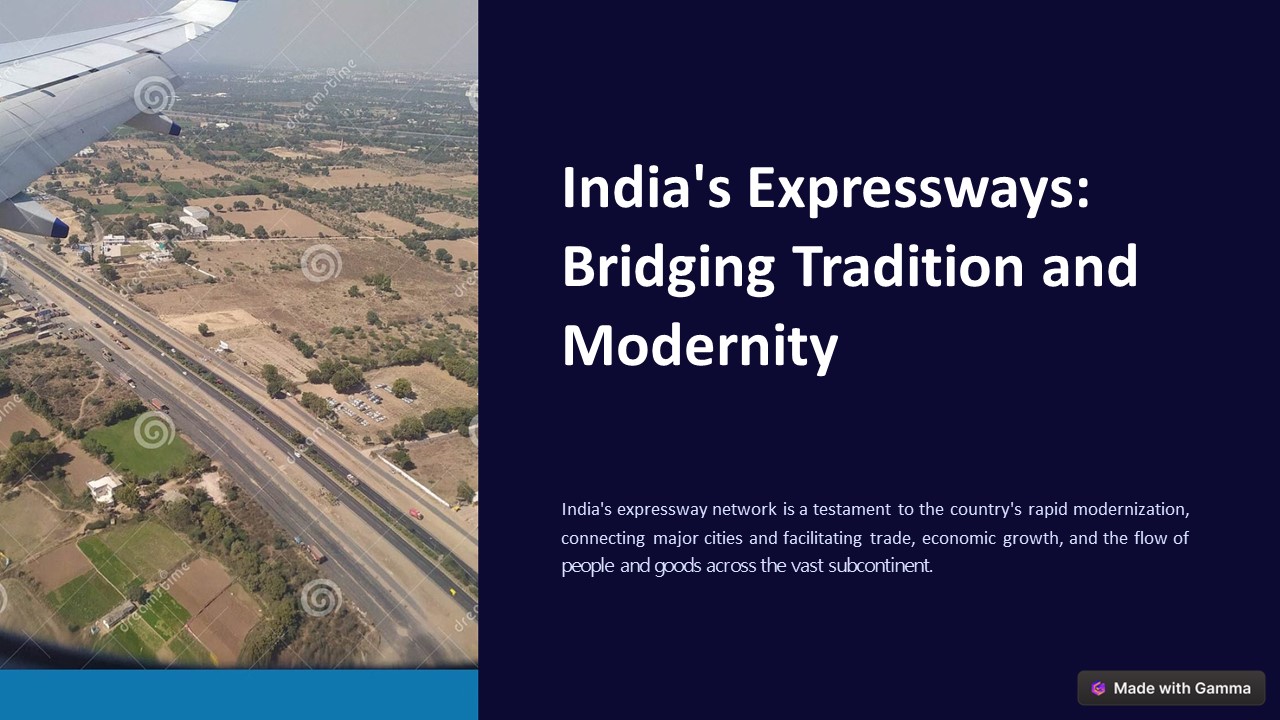India's Expressways Bridging Tradition and Modernity - PowerPoint PPT Presentation
Title:
India's Expressways Bridging Tradition and Modernity
Description:
India's expressways symbolize rapid modernization and economic growth. Connecting major cities and reducing travel time, they facilitate trade, tourism, and regional development. From the Mumbai-Pune Expressway to the ambitious Bharat Mala project, these arterial roads exemplify India's commitment to world-class infrastructure and a prosperous future. – PowerPoint PPT presentation
Number of Views:0
Title: India's Expressways Bridging Tradition and Modernity
1
India's Expressways Bridging Tradition and
Modernity
India's expressway network is a testament to the
country's rapid modernization, connecting major
cities and facilitating trade, economic growth,
and the flow of people and goods across the vast
subcontinent.
2
What Are Expressways?
Definition
Features
Significance
Expressways are controlled-access highways
designed for high-speed traffic, with minimal
intersections, flyovers, and underpasses.
These features allow for seamless, uninterrupted
travel, making expressways vital to India's
transportation infrastructure.
Expressways are a symbol of India's commitment to
swift and efficient transportation, fueling the
country's economic growth and development.
3
The First Expressway Mumbai-Pune
Inception
Impact
The Mumbai-Pune Expressway was conceived to
address the growing traffic congestion on the old
Mumbai-Pune Highway.
The expressway significantly reduced travel time
and facilitated economic development between the
two major cities.
1
2
3
Construction
The 94.5 km expressway, running from Kalamboli to
Dehu Road, was completed and opened to the public
in 2002.
4
Yamuna Expressway Connecting Delhi and Agra
Overview
Objective
The Yamuna Expressway is a 165 km, six-lane
expressway that connects New Delhi to Agra.
The primary aim of the Yamuna Expressway is to
reduce travel time between the two cities.
Features
Economic Zones
The expressway boasts electronic surveillance,
SOS booths, and the potential for future
expansion.
The expressway has also spurred the development
of residential and industrial zones along its
route.
5
Peripheral Expressways Decongesting Delhi
Eastern Peripheral Expressway
Western Peripheral Expressway
Impact
These peripheral expressways have successfully
redirected transit traffic, reducing congestion
and pollution levels in Delhi.
This 135 km expressway is solar-powered and
incorporates rainwater harvesting, further
enhancing its sustainability.
Spanning 135 km, the Western Peripheral
Expressway connects Kundli to Palwal via Manesar.
6
Agra-Lucknow Expressway Speed and Connectivity
Length and Completion
Features
1
2
The 302 km Agra-Lucknow Expressway is one of the
longest in India, built in just 23 months.
The expressway is six lanes wide, with the
potential to expand to eight, and even includes
provisions for aircraft landing.
Connectivity
3
The Agra-Lucknow Expressway links with the Yamuna
Expressway, enhancing regional connectivity and
accessibility.
7
The Benefits and Future of Expressways
Economic Development
Tourism Boost
Reduced Travel Time
Future Vision
Efficient connectivity attracts tourists,
leveraging India's diverse cultural and natural
attractions.
India aims to expand its expressway network to
50,000 km by 2025.
Expressways promote regional investment and
business, driving economic growth.
Expressways provide enhanced speed and fewer
stops, significantly cutting journey times.
8
Connect with Us
Website
YouTube































